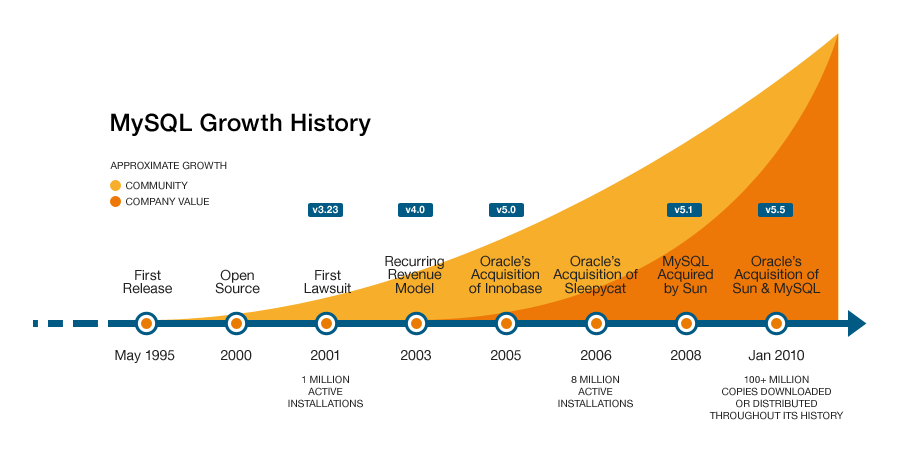This article was written on Database Friends. It is on Database, visualization and big data news. Blogs are about MySQL, PostgreSQL, Oracle, SQL Server and other DBMS.
MySQL is one of the most widely used open source relational database management systems in the world. With a total distribution amounting to more than 100 million worldwide, the software has become the first choice of large data management corporations spanning over a wide range of internet technologies.
Inception
Open Source Status
Originally the property of MySQL AB, the platform went open source in 2000 and began following the terms of GPL. Going open source resulted in a significant drop in revenues which were, however, recovered eventually. The open source nature of MySQL has made it open for the contributions of third party developers.
Expansion in Business
MySQL gained steady popularity among home and professional users and by 2001, the platform had 2 million active installations. In 2002, the company expanded its reach and opened US headquarters in addition to Swedish headquarters. Same year, it was announced that the membership of the platforms exceed 3 million users with revenue amounting to $6.5 million.
First Lawsuit
MySQL AB also faced its first major lawsuit in June 2001 when it was sued by NuSphere in US District Court in Boston. The charges included violation of third party contracts and unfair competition. In repose, MySQL AB sued NuSphere in 2002 for copyright and trademark infringement. Both companies reached at a settlement after preliminary hearing on 27 February 2002.
Shift in Strategy
The platform continued to gain popularity and by the end of 2003, it could boast total revenue of $12 million with 4 million active installations. In 2004, the company decided to focus more on recurring end user revenue instead of one-time licensing fee. The strategy proved to be profitable and the year ended with net revenue of $20 million.
What you can find in this article:
- Oracle’s Acquisition of Innobase
- Further Acquisitions of Oracle
- MySQL Acquired by Sun Microsystems
- Oracle’s Acquisition of Sun and MySQL
- MySQL Forks
- MySQL and Cloud Computing
To check out all this information, click here.
Top DSC Resources
- Article: What is Data Science? 24 Fundamental Articles Answering This Question
- Article: Hitchhiker’s Guide to Data Science, Machine Learning, R, Python
- Tutorial: Data Science Cheat Sheet
- Tutorial: How to Become a Data Scientist – On Your Own
- Categories: Data Science – Machine Learning – AI – IoT – Deep Learning
- Tools: Hadoop – DataViZ – Python – R – SQL – Excel
- Techniques: Clustering – Regression – SVM – Neural Nets – Ensembles – Decision Trees
- Links: Cheat Sheets – Books – Events – Webinars – Tutorials – Training – News – Jobs
- Links: Announcements – Salary Surveys – Data Sets – Certification – RSS Feeds – About Us
- Newsletter: Sign-up – Past Editions – Members-Only Section – Content Search – For Bloggers
- DSC on: Ning – Twitter – LinkedIn – Facebook – GooglePlus
Follow us on Twitter: @DataScienceCtrl | @AnalyticBridge

